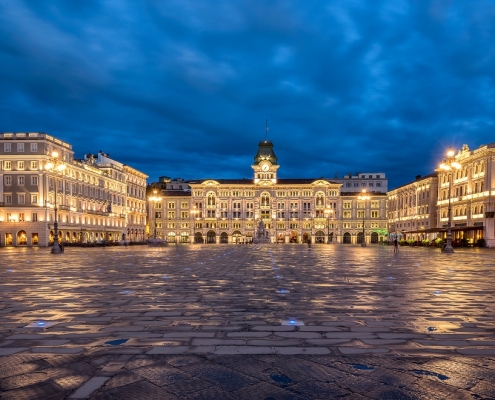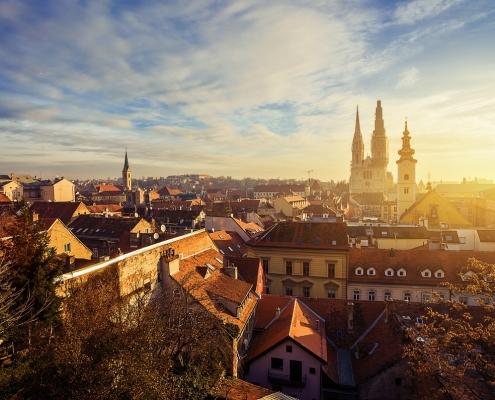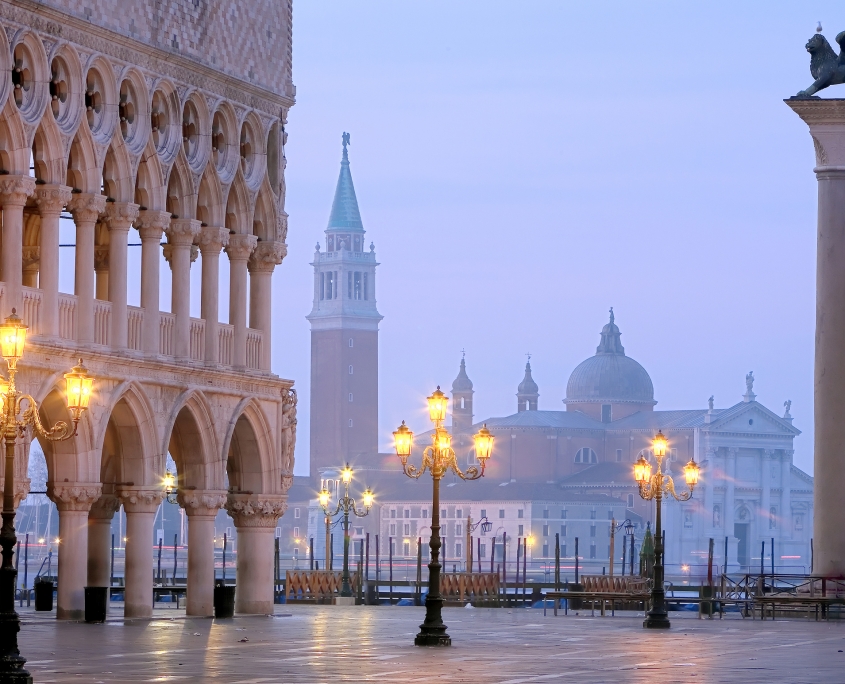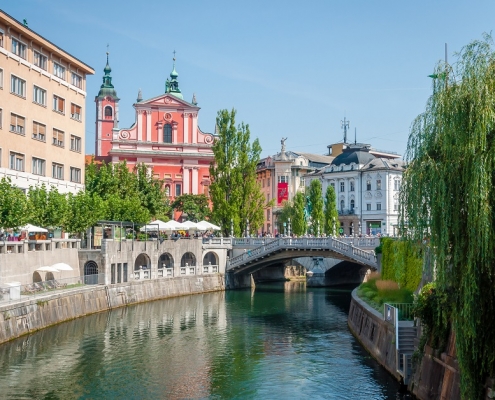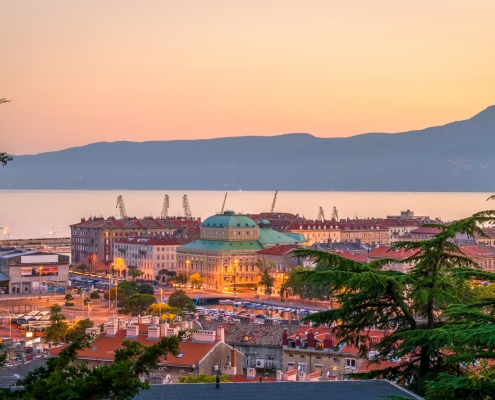City breaks in the Alps-Adriatic region
Your’ve already seen Barcelona, Paris or London? Trieste, Zagreb, Venice, Ljubljana and Rijeka are cities in the Alps-Adriatic region and are closer than you think. They all boast trendy town centres that are perfekt for leisurely strolls. We have explored these cool Alps-Adriatic cities for you and are exited to share your insiders’s tips! Find out where to find the best festivals and clubs, which hidden places you should definitely explore, and which cultural highlights are waiting to be discovered.
Trieste
It takes just over two hours to get from Klagenfurt to the Gulf of Trieste. A city that appears to be a pared-down version of Vienna at first glance: grandiose and magnificent, cosmopolitan, just a touch melancholic. But Trieste has one advantage over the much larger Vienna: It lies by the sea.
This beautiful city appears to have been poured into the landscape, tucked in between the steeply rising foothills of the Karst mountains and the Adriatic. Even the Adriatic has a bewitching charm here: Between the white canvases of the sailing ships that put to sea on fine days, vast ocean liners lie at anchor, waiting to be discharged of their cargo in the port of Trieste. What is it about this city of some 200,000 inhabitants that makes it so vibrant and splendid? The city has a lively history: a melting pot of cultures and people, its past closely interwoven with its future, its location as a border town both a curse and a blessing. As well as the Italian “buon giorno”, you will also hear the Slovenian “dober dan”.
For over 500 years, Trieste was part of the Habsburg Empire and Austria’s most important port. But those days are ancient history. Today, the magnificent architecture, first and foremost the Piazza Unità d’Italia, serves to remind us of past glory. The Italian region of Trieste hugs the sea in a narrow strip just below Slovenia. As if this were entirely its due, it confidently and cheekily pilfers the Slovenian coast. Historically Austrian, geographically Slovenian, one is left to wonder: Is Trieste actually an Italian city? And yet, sitting by the sea, enjoying the pleasant glow of the evening sun and sipping an espresso – called “nero”, the black one, in Triestine – this is the moment when Trieste truly reveals its Italian soul. Most of the sights within the compact historic centre can be reached on foot, which is why Trieste is ideal for a (long) weekend.
Teatro romano di Trieste
The amphitheatre was constructed in the first century AD and seated up to 6,000 spectators. The theatre is nestled at the foot of the Colle di San Giusto hill. Right there, where the old town climbs up the hill, visitors can wander through the narrow medieval alleys. Having reached the top of the hill, you can visit the castle and the Cathedral of San Giusto, dedicated to the patron saint of Trieste.
The Canal Grande
The Grand Canal stretches from the sea right into the city, all the way to the imposing Serbian Orthodox Church. While not quite as grandiose as its namesake in Venice, a stroll along the Canal Grande is delightful, nonetheless. Small boats bob in the water, while above them, you can enjoy a relaxed aperitivo in one of the many cafés that line the waterway.
Browsing through the antique and second-hand shops
In the old Jewish quarter of the city, many antique and second-hand dealers have set up shops. There’s also a large flea market here every third Sunday of the month.
Sunset on the Molo Audace
It’s something of a tradition in Trieste: To enjoy the sunset, you head for the Molo Audace. The pier juts out 200 metres into the Gulf of Trieste.
Escape to a fairy-tale castle
Trieste is home to a fairy-tale castle, the Castello di Miramare. This gorgeous white castle was built in 1860 at the behest of a brother of the Austrian emperor and it perches high above the sea, surrounded by a pretty park.
A refreshing dip in the sea
Trieste is not a traditional seaside resort, but it does offer plenty of spots where you can cool off in the sea. During the summer, the beach promenade in the Barcola district is always the first choice. The tree-lined avenue is dotted with summer bars. Between them, there is a lively summer atmosphere. Alternatively, you can take the Delfino Verde taxi boat to the pretty fishing village of Muggia and enjoy a delicious meal in one of the small restaurants in the harbour.
Italian shopping
The Borgo Theresiano, the pedestrian zone, is home to a large number of shops, including big retail chains and smaller independent shops.
Turning the night into day
In Via Torino, night becomes day in Trieste. This is THE hotspot for partying. Trieste is a student city, and you can tell, especially on Thursday, Friday and Saturday nights! From Via Torino it is only a few metres to the San Giusto pier. Here, overlooking the sea, you will find one of the best rooftop bars, “Pier The Roof”.
Piazza d’Unitá d’Italia
There is a good reason why the Piazza is considered one of the most beautiful squares in the world. This vast square, lined with splendid buildings, offers a wonderful view of the Gulf of Trieste. This is a great place to relax after a day of sightseeing and savour Trieste’s coffee.
Insider’s tip
The Karst mountains above Trieste are home to a large number of traditional wine taverns, known as Osmize. Many of these little gems, often run by members of the Slovenian-speaking minority, enjoy spectacular views of the sea. The Osmize may only sell what they have produced themselves.
www.osmize.com
Zagreb
Croatia’s state capital, Zagreb, is only about two hours’ drive from Klagenfurt. Cobbled, winding lanes and historic buildings make Zagreb a great tourist destination that is off the beaten track.
The best place to start a tour of Zagreb is from Ban Jelačić Square. The Habsburgs played a part here too, as Ban Josip Jelačić was once the commander of the Habsburg troops in Croatia. This square surrounded by the city’s pedestrian zone is a popular meeting place for many locals. Shopping is best around the streets Ilica and Tkalčićeva. Here you’ll find everything your heart desires in addition to the offerings of up-and-coming young Croatian designers. Traditional handicraft can be found around Radićeva Street. If you have a sweet tooth, you definitely need to visit the “sweet street”, Stara Vlaška, an absolute paradise for all lovers of sweets.
The Upper Town
Zagreb’s Upper Town is a maze of countless narrow lanes sandwiched between two hills, Kaptol and Gradec. Here you will find the Stone Gate, St. Mark’s Square and the Croatian Parliament, and the Dolac market, a wonderful market with regional and authentic offerings. By the way, it’s worth going to the market very early to watch the hustle and bustle. Zagreb’s Gothic cathedral is also located in the Upper Town. The Museum of Broken Relationships, in the Upper Town, a museum that is not only interesting for the lovelorn, can also be found here. In addition to the known attractions, the city has many stylish cafés where you can relax and unwind. Coffee served with syrup and milk is very typical for Zagreb, and you should definitely give it a try.
A stroll in the park …
Don’t miss a visit to Maksimir, the oldest park in Croatia. You can reach the park very easily by taking tram number 11 or 12 from Ban Jelačić Square.
Thrilling nightlife in Zagreb
Concerts are held regularly in the “culture factory”, Tvornica kulture. Next to the main hall, there is also a smaller hall, the Mali Pogon, which doubles as a café during the day. Alternative music can be heard at Club Močvara. This venue offers live music, theatre performances and art exhibitions. The Aquarius is another popular party venue. Things are a little more tranquil in the Swanky Monkey Garden. You will find the best cocktails in town here.
Festivals in Zagreb
The Music Biennale Zagreb and the Zagreb Film Festival are two absolute highlights not to be missed.
Insider’s tip
Outdoor adventures on the Kupa and Mrežnica rivers. Although Zagreb is located inland, you can experience the ultimate adrenaline rush on the Kupa and Mrežnica rivers: Rafting, kayak tours and canoeing are on offer here.
Venice
Venice: It’s the Rialto Bridge, the Grand Canal, St Mark’s Square and the Doge’s Palace. However, while you are in Venice, you should not only visit the traditional sights mentioned above, but also make sure to go to one of the islands off the coast: Murano (famous for its glass art), Torcello and Burano. The Venice Biennale is definitely a must-see. And a visit to the Peggy Guggenheim Collection is always rewarding.
What’s the best way to explore Venice?
From Piazzale Roma onwards, all cars and bicycles as well as trains are banned in the historic centre. From here on in, visitors have to rely on footpaths and waterways. Venice lends itself to being explored on foot, but beware: There are roughly 400 bridges with steps! Various vaporetti (regular boats) and some private boats operate on the water. Watch out for the extremely pricey taxi boats! Vaporetto lines 1 and 2 run from Piazzale Roma via the railway station (Ferrovia) and Rialto to St Mark’s Square.
The honest truth?
Of course, Venice is a tourist city – if not THE tourist city. Nevertheless, it really is worth a visit. Venice is simply stunning. There’s even something to be said for a gondola ride – though some of the smaller canals can make you feel like you’re in a traffic jam on a gondola highway. Also: Even Venice is a little quieter outside of the tourist season.
Spending the night in Venice
Accommodation is expensive and hard to come by. Try to avoid staying on the ground floor in hotels or apartments, as they can be quite dark and damp. The Lido di Venezia, which separates the lagoon from the open Adriatic, is also a good place to stay off-season – and a wonderful place to take a walk. Be sure to compare the prices that are offered on the booking platforms – and always read between the lines when it comes to the information provided by the operators.
Getting there and parking
Travel by bus or train if possible. The bus terminus is called Tronquetto. Buses depart from Villach several times a day. The journey from Carinthia by train is also very convenient.
Ljubljana
Ljubljana is a very romantic city, due in part to the Ljubljanica River, which flows through its centre. The modern part of the city lies to the west of the Ljubljanica, while the old town with its narrow alleys and impressive castle is located on the eastern side.
Ljubljana is the capital of Slovenia, but it is compact and well laid out and therefore very easy to explore on foot. The city’s bus network is very efficient. You definitely shouldn’t miss out on visiting Ljubljana Castle. You can choose the sporty approach and walk up from the old town. Alternatively, weary travellers can take the funicular, which can carry 33 passengers and covers the 70-metre climb in a single minute.
Tivoli Castle, located at the heart of Tivoli Park, also deserves a visit. Nowadays, the building houses the International Graphics Centre. Be sure to visit the market and its colonnades, where the fish market is located. This market is one of the most authentic and largest far and wide and is absolutely worth a visit with its blaze of colour and variety. On Sundays you will find an arts and crafts market between the Cevljarski Bridge (Cobbler’s Bridge) and the three inner-city bridges spanning Ljubljanica.
Museums
Ljubljana boasts a number of good museums, including the National Museum of Slovenia, the Museum of Modern Art and the City Museum. For those looking for something a little more unusual, we can also recommend the Union Brewery Beer Museum.
Nightlife
Ljubljana is very lively and pleasant city with a large university. The nightlife is varied and buzzing. Start your evening in one of the many small cafés and bars and then just let yourself drift.
Getting there
You can reach Ljubljana comfortably by Flixbus.
Rijeka
Rijeka is one of Croatia’s most important seaports. The city’s somewhat earthy charm might not be immediately apparent, but if you give Rijeka a little time, you are guaranteed to fall in love with this authentic city that remains relatively neglected by the bulk of tourists.
The city’s history is complex, but Rijeka’s most important role – and this also applies to the Habsburg period (yes, the Austrians really did go everywhere!) – is that of a major trading centre. Sumptuous villas constructed in the 19th century in the architectural styles of the Baroque and Renaissance periods, bear witness to the former wealth of this port city. The Modello Palace and the Ploech Palace are especially noteworthy.
Points of interest, especially at night, include the two old harbour cranes dating from 1948 and 1957, which are symbolic of Rijeka’s industrial heritage. A visit to the Trsat fortress, on the other hand, is a medieval experience. The fort lies at 148 metres above sea level and dominates the cityscape most impressively. Trsat is one of the oldest fortresses in Croatia.
The Korzo is the longest pedestrian avenue in the city, and anyone who enjoys shopping will be in their element here. The market square and the municipal tower are the busiest areas. Here you can watch the hustle and bustle of the market, and connoisseurs of regional, fresh and sustainably produced goods are in the right place. A visit to the fish hall is also recommended.
Then, in the evening, as the sun sinks into the Kvarner Bay, there is an enormous range of traditional Croatian konobas to choose from. The menus are dominated by seafood, fish and regional vegetables. A hot tip is to try something prepared in a peka, a bell made of clay or cast iron that is covered with hot embers. If you want to try this Croatian delicacy, you should order ahead, as this traditional method of cooking over the fire does take some time.
For lovers of the Adriatic
A walk along the Molo Longo via the harbour wall to the lighthouse at the end of the quay takes around 30 minutes. From here, you can enjoy a marvellous view of the city of Rijeka, the Istrian peninsula and the islands of Krk and Cres. Lots of wonderful Croatian islands can be reached by ferry from Rijeka. In other words, Rijeka is not only perfect for a city break, but also as a stopover on the way to one
of the nearby islands. For ferry connections please visit jadrolinija.hr.
Insider’s tip
Pajol-Bar Pecine, beach bar
Trendy beach bar with music and books to borrow for the beach. Open daily in the summe months when the weather is good.
Club Mladih Rijek, bar/youth club
Student bar in a central location with reasonable prices and regular concerts & events.
Sugar Palace – Rijeka City Museum
Modern exhibition dedicated to the cultural, political and economic history of the city of Rijeka.










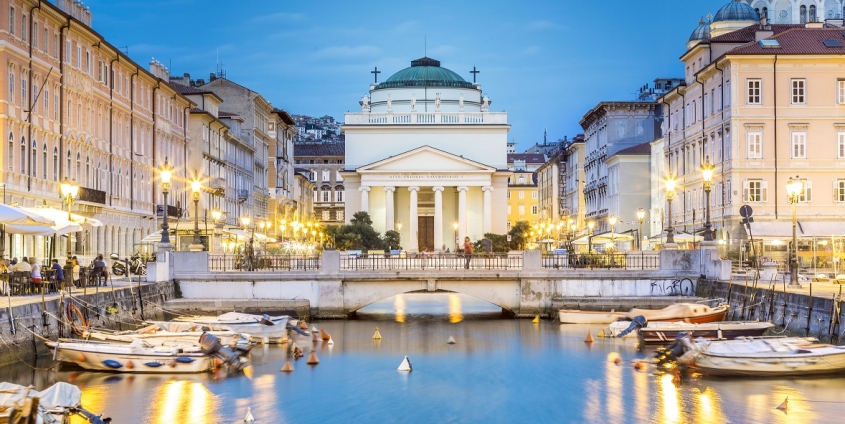 Foto: eunikas/Fotolia
Foto: eunikas/Fotolia